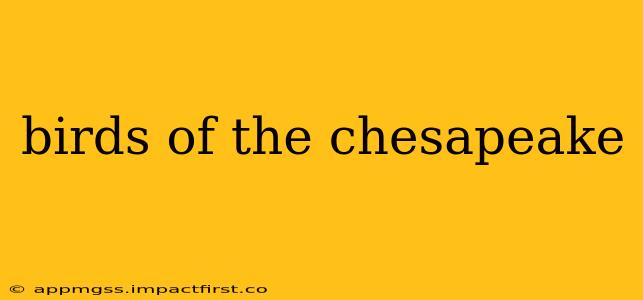The Chesapeake Bay, a vast and vibrant estuary, is a haven for a remarkable diversity of birdlife. From majestic bald eagles soaring overhead to tiny marsh wrens flitting through the reeds, the avian inhabitants of this ecosystem are as varied and captivating as the landscape itself. This comprehensive guide explores the fascinating world of Chesapeake Bay birds, delving into their habitats, behaviors, and the conservation efforts vital to their survival.
What types of birds live in the Chesapeake Bay?
The Chesapeake Bay supports an astonishing array of bird species, categorized broadly into several groups based on their habitats and feeding preferences. These include:
-
Shorebirds: These birds thrive along the bay's extensive shorelines, mudflats, and beaches. Examples include the American oystercatcher, sanderling, and various species of plovers and sandpipers. These birds are highly adapted to foraging in shallow waters and on exposed mudflats, often using their long bills to probe for invertebrates.
-
Waterfowl: Ducks, geese, and swans make up a significant portion of the bay's bird population. Species like the canvasback, redhead, and black duck are particularly associated with the Chesapeake, their numbers fluctuating seasonally with migration patterns. These birds are adept swimmers and divers, feeding on aquatic plants and animals.
-
Wading Birds: Herons, egrets, and ibises are prominent wading birds found throughout the bay's marshes and shallow waters. Their long legs and necks allow them to navigate shallow areas, hunting for fish, crustaceans, and other aquatic prey. The Great Blue Heron is a particularly common and easily recognizable sight.
-
Marsh Birds: The extensive marshes of the Chesapeake are home to a variety of specialized birds, including marsh wrens, seaside sparrows, and clapper rails. These birds are masters of camouflage, blending seamlessly into their reed-filled surroundings.
-
Birds of Prey: The Chesapeake supports a healthy population of raptors, with the bald eagle being perhaps the most iconic. Other birds of prey frequently seen include osprey, red-tailed hawk, and peregrine falcon. These birds play a crucial role in maintaining the ecosystem's balance.
What are the best places to birdwatch in the Chesapeake Bay?
Numerous locations throughout the Chesapeake Bay offer exceptional birdwatching opportunities. The best sites often depend on the time of year and the specific species you're hoping to see. Popular areas include:
-
Blackwater National Wildlife Refuge: This refuge provides expansive marshes and tidal flats, making it a prime location for observing a wide range of waterfowl, shorebirds, and marsh birds.
-
Assateague Island National Seashore: This barrier island offers incredible opportunities to spot shorebirds, raptors, and migratory birds.
-
Chesapeake Bay Bridge-Tunnel: The bridge-tunnel offers unique viewing platforms, allowing observers to witness large flocks of migrating birds.
What is the best time of year to birdwatch in the Chesapeake Bay?
The best time to birdwatch in the Chesapeake Bay depends largely on your target species. Migration periods – spring and fall – are generally excellent times to see a great diversity of birds. Spring migration often brings spectacular displays of warblers and other songbirds, while fall migration features massive flocks of waterfowl. Summer is a good time to observe nesting birds and their young. Winter offers opportunities to see waterfowl concentrated in open water areas.
What are some threats to birds in the Chesapeake Bay?
The Chesapeake Bay ecosystem, like many others, faces significant challenges that impact its bird populations. Key threats include:
-
Habitat loss and degradation: Development, pollution, and alterations to natural waterways reduce suitable habitat for many bird species.
-
Climate change: Rising sea levels, altered weather patterns, and increased storm frequency negatively impact coastal ecosystems and the birds that rely on them.
-
Pollution: Chemical contaminants, nutrient runoff, and plastic pollution can directly harm birds and disrupt their food sources.
-
Invasive species: Non-native plants and animals compete with native species for resources, impacting bird populations.
How can I help protect the birds of the Chesapeake Bay?
Protecting the birds of the Chesapeake Bay requires a multifaceted approach involving individual actions and broader conservation initiatives. You can help by:
-
Supporting conservation organizations: Many organizations work to protect the bay's ecosystem and its wildlife. Donations and volunteer efforts can make a significant difference.
-
Reducing your environmental impact: Practicing responsible waste disposal, reducing energy consumption, and supporting sustainable practices helps protect the bay's overall health.
-
Participating in citizen science projects: Citizen science initiatives such as bird counts provide valuable data to guide conservation efforts.
-
Advocating for protective policies: Support legislation and regulations aimed at protecting the Chesapeake Bay and its wildlife.
By understanding the challenges facing the birds of the Chesapeake Bay and engaging in responsible stewardship, we can help ensure that this extraordinary avian diversity continues to thrive for generations to come. The beauty and ecological significance of these birds are an invaluable asset to the region, and their preservation is a responsibility we all share.
